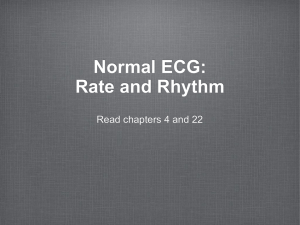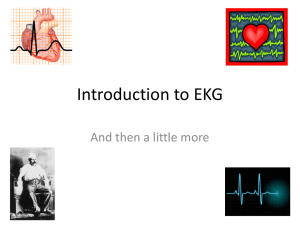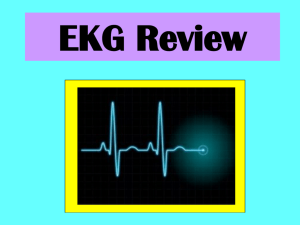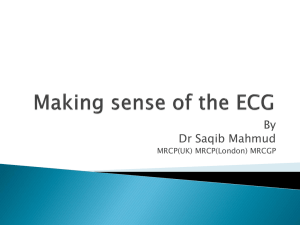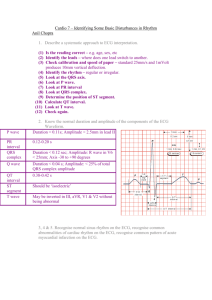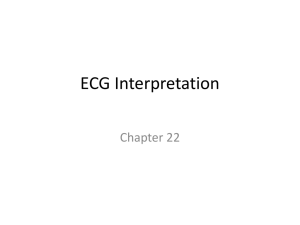Guide For Arrhythmia Recognition
advertisement
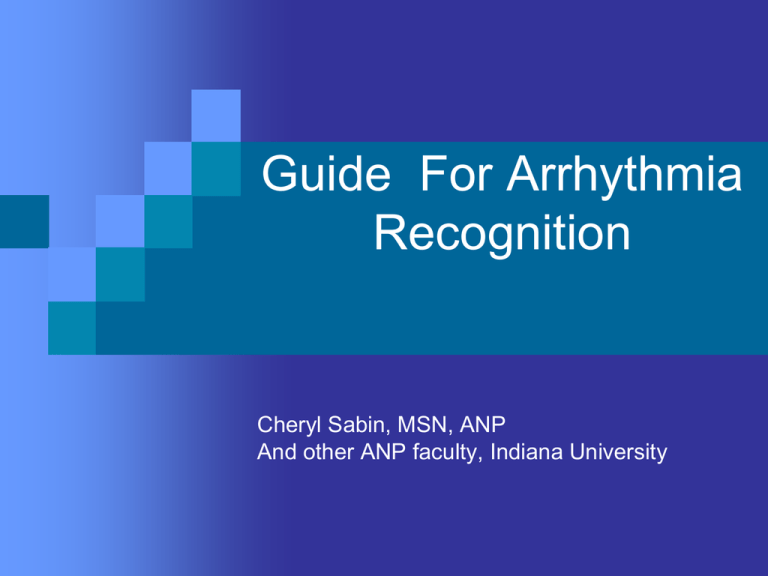
Guide For Arrhythmia Recognition Cheryl Sabin, MSN, ANP And other ANP faculty, Indiana University Objectives Recognize and explain the basic conduction system of the heart Able to accurately measure: PR interval QRS duration QT interval Analyze the rate and rhythm of EKG strips Objectives Recognize and distinguish what area of the conduction system is pacing the heart Able to state appropriate treatment responses to various identified rhythm strips The ECG Electrodes on the skins surface records the electrical activity of the heart. Monitoring cables are connected to the skin electrodes and attached to the monitor or ECG machine The horizontal axis corresponds with time. The vertical axis = voltage or amplitude. ECG Paper ECG paper normally records at 25mm/se Each horizontal 1mm box represents 0.04 sec. (25mm/sec x 0.04 sec = 1mm). ECG Paper The lines between every 5 boxes are heavier indicating one large box. Each large horizontal box is 0.20 sec 5 large boxes = 1 sec. Thirty large boxes = 6 sec. A small box is 1 mm high, a large box is 5mm high. Paper Waveform Movement away from the baseline in either a positive or negative direction Segment A line between waveforms; named by the waveform that precedes or follows it Interval A waveform and a segment Complex Several waveforms *Waveform* P Wave: represents atrial depolarization and the spread of the electrical impulse throughout the right and left atria. P Wave Characteristics: Smooth & round No more than 2.5 mm in height or 0.11 sec in duration PR PR Segment: horizontal line between the end of the P wave and the beginning of the QRS complex. Normally isoelectric PR Interval: P wave + PR segment = PRI Represents the interval between the onset of atrial depolarization and ventricular depolarization. PRI Time from impulse from SA to AV node PR Cont. PR Interval cont. Measured from the point where the P wave leaves the baseline to the beginning of the QRS. Normally measures 0.12 to 0.20 sec. Normally shortens as heart rate increases. QRS QRS Complex: consists of the Q, R, & S waves and represents the spread of electrical impulse through the ventricles. Ventricular depolarization. Q Wave: is always a negative waveform. It represents depolarization of the interventricular septum Measures less than 0.04 sec in duration and less than 25% of the amplitude of the R wave. Waveforms R Wave: is the first positive deflection of the QRS S Wave: is a negative deflection following a R wave. Waveforms The R & S wave represents the simultaneous depolarization of the R & L ventricles. The QRS complex typically represents the electrical activity which occurs within the Left ventricle due to it’s greater muscle mass. QRS Measuring of QRS The width of the QRS is taken from the point where the first wave of the complex leaves the baseline. The point at which the last wave form returns to the baseline marks the end of the QRS complex. Duration of the QRS varies between 0.06 and 0.10 sec. ST ST Segments: portion between the QRS complex and the T wave. Is the term used regardless of the final wave of the QRS. Represents the early part of repolarization of the R&L ventricles. Normal ST segment is isoelectric Waveforms T Wave: Represents ventricle repolarization. The absolute refractory period ends at the peak of the T wave and the relatively refractory period begins. Waveform T Wave Characteristics: The T wave is typically oriented in the same direction as the preceding QRS complex. The T wave is slightly asymmetric QT QT Interval: Represents the time from ventricular depolarization to repolarization. QT is measured from the beginning of the QRS complex to the end of the T wave. To determine if the QT is WNL: measure between R-R waves. If the QT interval is less than ½ the R-R interval it is considered normal. QTc Interval Table HR/min R-R Interval (sec) 40 1.5 QTc (sec) & Normal range 0.46(0.41-0.51) 50 60 70 80 90 1.2 1.0 0.86 0.75 0.76 0.42(0.38-0.46) 0.39(0.35-0.43) 0.37(0.33-0.41) 0.35(0.32-0.39) 0.33(0.30-0.36) QTc Interval Table HR/min R-R Interval (sec) QTc (sec) & Normal range 100 0.60 0.31(0.28-0.34) 120 0.50 0.29(0.26-0.32) 150 0.40 0.25(0.23-0.28) 180 0.33 0.23(0.21-0.25) 200 0.30 0.22(0.20-0.24) Calculating Rate Assess the Rate: Six-second Ventricular Rate: count the number of QRS complexes in the 6 sec. strip and multiply that number by 10. Large Method: 30 large boxes = 6 sec. Box Method: Count the number of large boxes between 2 consecutive R waves and divide into 300. May also calculate the Atrial rate the same way. Calculating Rate Sequence Method: Select an R wave that falls on a dark vertical line. Number the next 6 consecutive dark vertical lines as follows: 300, 150, 100, 75, 60, and 50. Sinus Rhythms Normal Sinus Rhythm or Regular Sinus Rhythm(NSR,RSR) Rate: 60-100. Rhythm: regular. P waves Configuration: All look alike; upright in standard leads I,II, aVF, inverted in aVR P-R interval: Normal 0.10-0.20 seconds and constant QRS duration: Normal 0.04-0.12 seconds. NSR Sinus Bradycardia Rate: less than 60 beats per minute. Rhythm: Regular. P waves: Configuration: all look alike(see NSR) one P before each QRS. P-R interval: Normal 0.10-0.20 seconds and constant. QRS duration: Normal 0.04-0.12 seconds. Sinus Brady What drugs induce SB? When do you treat SB? Why do they have symptoms? Sinus Tachycardia (Sinus Tach) Rate: 100-150( maybe 180, depends on who’s book you read!) Rhythm: Regular P waves: All look alike( see NSR). One P wave before each QRS PRI: Normally shortens as heart rate increases. QRS duration: Normal 0.04-0.12 sec. Sinus Tach Sinus Arrhythmia (happens to all of us!) Rate: 60-100 but it is variable. Rate increases with inspiration and decreases with expiration. Rhythm: Irregular; varies with respiratory cycle Sinus Arrest Rate: Variable; often slow Rhythm: Interrupted by pauses when the SA node “fails to fire.” Regular until absence of a P wave; duration of the pause is not a multiple of the P-P interval or the underlying rhythm Sinus Arrest Sinus Block(SA Exit Block) Impulse originates in pacemaker cells of SA node but is blocked as it exits. Rate: Variable; often slow Rhythm: Regular except for pause periods; overall the rhythm is not interrupted. SA block Atrial Arrhythmias Premature Atrial Contractions P waves: Shape of premature P wave often differs. One P wave for each QRS. PAC occurs early; no compensatory pause(usually). P-R interval: Interval for PAC usually different than is sinus cycles. QRS duration: Normal duration; QRS of premature beat usually the same as the sinus conducted QRS Rhythm: Interrupted by premature contraction NSR PAC Atrial Tachycardia Paroxysmal Atrial Tach-PAT Rate: 180-250 Rate is the only difference from Sinus Tach. Rhythm: Regular unless associated with AV block-PAT marked by sudden onset and sudden cessation. P waves: Often buried in preceding T wave-tent like appearance.One P for each QRS P-R interval: Not measurable because of rapid rate. Atrial Flutter Rate: Ventricular rate varies depending upon the degree of AV block( 250-350).It is Regular. Rhythm: Dependent on block; regular if block is constant P Waves: Flutter waves are saw tooth pattern or undulating atrial waves. P-R interval: Not measured. QRS duration: Normal A. Flutter pathways A. Flutter A. Flutter ??? What if the rate is so fast you can’t tell what they are in???? What is SVT? What does this do to CO? SVT vs. A.Flutter Rhythm strip following Adenosine Atrial Fibrillation Ventricular rate > 100 = uncontrolled <100 = controlled Atrial rate: 350-500 Rhythm: Usually Irregular ! P waves: Not identifiable P-R interval: Can’t be determined QRS duration: Normal A. Fib. Electrical Pathways A. Fib A. Fib Class I Class IIa Class IIb Class III Benefit >>> Risk Benefit >> Risk Additional studies with focused objectives needed Benefit ≥ Risk Additional studies with broad objectives needed; Additional registry data would be helpful Risk ≥ Benefit No additional studies needed Procedure/ Treatment SHOULD be performed/ administered IT IS REASONABLE to perform procedure/administer treatment Procedure/Treatment MAY BE CONSIDERED AHA Procedure/Treatment should NOT be performed/administered SINCE IT IS NOT HELPFUL AND MAY BE HARMFUL AHA Wandering Pacemaker Rate: usually slow, but may be 60-100 Rhythm: usually regular, but there is no reason it has to be! Wandering Pacemaker P waves: May vary depending on the origin of the impulse. One P for each QRS (maybe) P-R interval: Varies as pacemaker wanders between SA node, atrial tissue, and AV node. QRS duration: Normal WAP
